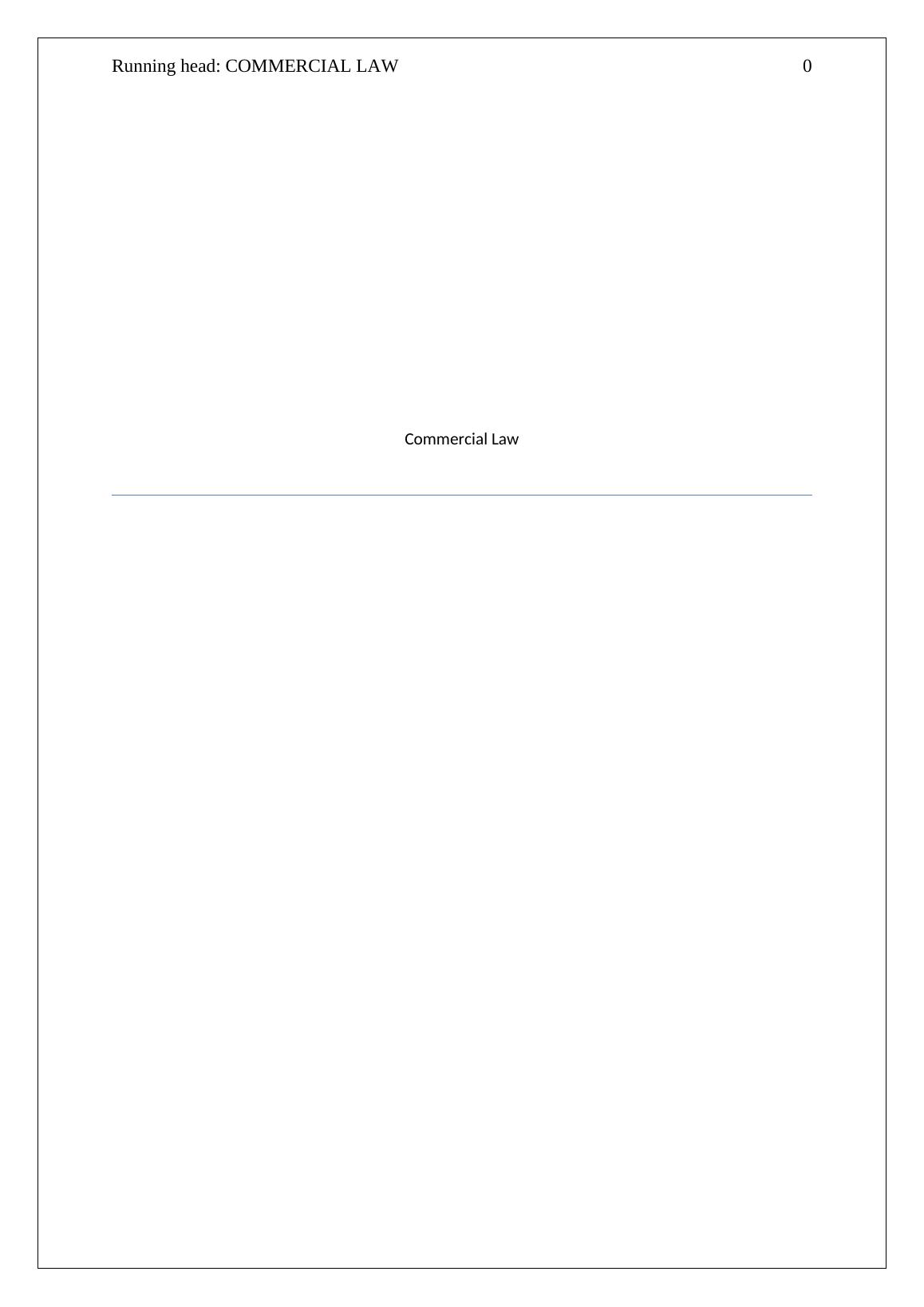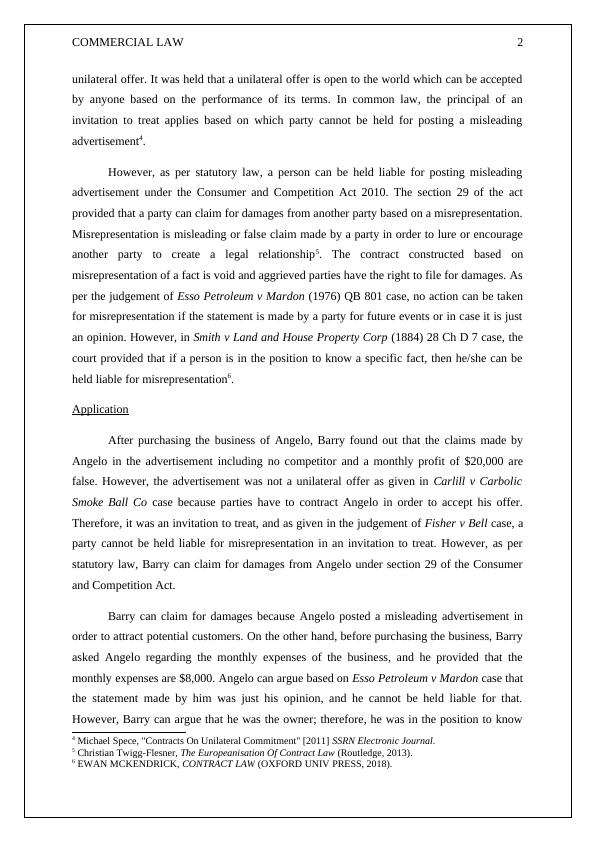Assignment on Commercial Law (Solved)
6 Pages1588 Words58 Views
Added on 2021-05-27
Assignment on Commercial Law (Solved)
Added on 2021-05-27
ShareRelated Documents
Running head: COMMERCIAL LAW0Commercial Law

COMMERCIAL LAW1Part-BQuestion 2IssueIn this case, the issue is whether a valid contract constructed between Barry andAngelo given that Angelo made a false statement in his advertisement before the contract wasconstructed?RuleA contract is defined an as written or oral agreement which is enforceable by the law.There are certain requirements which are necessary to be fulfilled by parties to create acontract. The essential elements include an agreement between parties, the intention toestablish a legal relationship and valid consideration. Offeror is the person making the offerand the person to receiving such offer is the offeree. Offeror is the person making the offerand the person to receiving such offer is the offeree. An offer is required to be made by aparty with an intention for establishing a legal realtionship1. An offer is different from aninvitation to treat. The purpose of an offer is to commit two or more parties into a contractwhich is why it is necessary that the offeror made a full commitment in the contract whichmeans that if the offer is accepted by the offeree than both the parties enter into a legalcontract, whereas, an invitation to treat did not bind parties to a contract instead it is just asupply of information2. The parties have to contract with each other in order give their acceptance afterreceiving an invitation to offer. In Fisher v Bell (1961) 1 QB 394 case, the court differentiatean offer from an invitation to treat. In this case, a knife was displayed in the shop based onwhich a police officer arrested the shopkeeper because it was illegal to sell that knife.However, the court held that it was an invitation to treat because the potential customers arerequired to contact the seller in order to purchase such knife, therefore, it was not an offer forsale3. Most advertisements are considered as an invitation to treat however in Carlill vCarbolic Smoke Ball Co (1892) EWCA Civ 1 case; the court implied the concept of the1Mindy Chen-Wishart,CONTRACT LAW(OXFORD UNIV PRESS, 2018).2Daniel Khoury and Yvonne S Yamouni,Understanding Contract Law(LexisNexis Butterworths, 2009).3Stephen Graw,An Introduction To The Law Of Contract(Thomson Reuters (Professional) Australia Pty Limited, 2017).

COMMERCIAL LAW2unilateral offer. It was held that a unilateral offer is open to the world which can be acceptedby anyone based on the performance of its terms. In common law, the principal of aninvitation to treat applies based on which party cannot be held for posting a misleadingadvertisement4. However, as per statutory law, a person can be held liable for posting misleadingadvertisement under the Consumer and Competition Act 2010. The section 29 of the actprovided that a party can claim for damages from another party based on a misrepresentation.Misrepresentation is misleading or false claim made by a party in order to lure or encourageanother party to create a legal relationship5. The contract constructed based onmisrepresentation of a fact is void and aggrieved parties have the right to file for damages. Asper the judgement of Esso Petroleum v Mardon (1976) QB 801 case, no action can be takenfor misrepresentation if the statement is made by a party for future events or in case it is justan opinion. However, in Smith v Land and House Property Corp (1884) 28 Ch D 7 case, thecourt provided that if a person is in the position to know a specific fact, then he/she can beheld liable for misrepresentation6.ApplicationAfter purchasing the business of Angelo, Barry found out that the claims made byAngelo in the advertisement including no competitor and a monthly profit of $20,000 arefalse. However, the advertisement was not a unilateral offer as given in Carlill v CarbolicSmoke Ball Co case because parties have to contract Angelo in order to accept his offer.Therefore, it was an invitation to treat, and as given in the judgement of Fisher v Bell case, aparty cannot be held liable for misrepresentation in an invitation to treat. However, as perstatutory law, Barry can claim for damages from Angelo under section 29 of the Consumerand Competition Act. Barry can claim for damages because Angelo posted a misleading advertisement inorder to attract potential customers. On the other hand, before purchasing the business, Barryasked Angelo regarding the monthly expenses of the business, and he provided that themonthly expenses are $8,000. Angelo can argue based on Esso Petroleum v Mardon case thatthe statement made by him was just his opinion, and he cannot be held liable for that.However, Barry can argue that he was the owner; therefore, he was in the position to know4Michael Spece, "Contracts On Unilateral Commitment" [2011]SSRN Electronic Journal.5Christian Twigg-Flesner,The Europeanisation Of Contract Law(Routledge, 2013).6EWAN MCKENDRICK,CONTRACT LAW(OXFORD UNIV PRESS, 2018).

End of preview
Want to access all the pages? Upload your documents or become a member.
Related Documents
Legal Advice on Issues Faced While Entering into a Contract with Angelolg...
|8
|707
|483
Validity of Contract and Misrepresentation under Common and Statutory Lawlg...
|7
|900
|202
Business Law | Assignment Samplelg...
|7
|1551
|46
Commercial law - Sample Assignmentlg...
|8
|595
|37
Business Law: Contract Law and Misrepresentationlg...
|7
|1778
|80
Invitation Treat in Business Law Assignmentlg...
|6
|1013
|138
